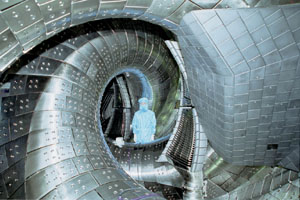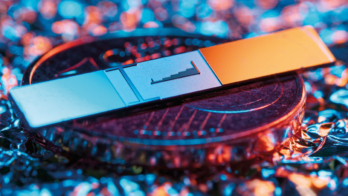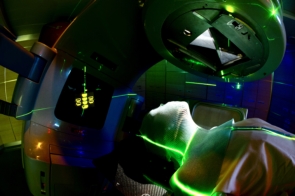Despite the events of 11 September, 655 out of a record 700 enrolled delegates managed to attend the 17th International Conference on Magnet Technology, MT-17, held that month at the Geneva International Conference Centre. They were rewarded with a varied programme covering topics from particle accelerators to maglev trains.

Represented in the MT-17 delegate list were 27 countries, giving an indication of the growing importance of magnet technology. An industrial exhibition at the conference was attended by 30 companies. A busy schedule saw 12 invited papers being delivered in plenary sessions; 34 invited and 79 contributed papers in parallel sessions; and 440 poster presentations. Doing justice to such a wide range of presentations, many of outstanding quality, is an impossible task; so the conference proceedings, which are due to be published in the spring as a dedicated issue of the Institute of Electrical and Electronic Engineers’ (IEEE) Transactions on Superconductivity, will give the full picture.
High-energy physics and astrophysics

MT conferences, high-energy physics and fusion dominated the intermediate-field strength (1-10 Tesla) applications. High-energy physics is at present a major user of magnets and it drives their development. Several interesting presentations covered the magnets of CERN’s 27 km circumference Large Hadron Collider (LHC), which is currently under construction. The laboratory’s Lucio Rossi revisited the basic concepts of superconducting accelerator magnet construction and reported on the progress of the industrial production of LHC dipoles (see news). The machine’s insertion magnets, which are being produced at several sites around the world (CERN Courier October 2001 p28), were presented by Ranko Ostojic of CERN, Sandor Feher of Fermilab, Toru Ogitsu of Japan’s KEK and Erich Willen of Brookhaven. In his plenary talk on the status of the LHC, project director Lyn Evans reported on the successful powering of a complete and final LHC magnet string. Speaking about the LHC experiments, Herman ten Kate, Alain Hervé, Wilfried Flegel and Detlef Swoboda, all from CERN, described good progress in magnet construction for ATLAS, CMS, LHCb and ALICE respectively.
Moving away from the host laboratory, Michael Harrison from Brookhaven in the US discussed the successful magnet performance during the commissioning of the Relativistic Heavy-Ion Collider (CERN Courier July/August 2000 p5). Reports on the use of permanent magnets in the Fermilab recycler showed a remarkable progress in solving the problems of strength adjustment, thermal stability and homogeneity. The future for particle accelerators was outlined by several speakers, including Steve Gourlay of the Lawrence Berkeley National Laboratory and Peter Limon of Fermilab, who reported on the different designs and high-field magnet developments for a possible future Very Large Hadron Collider – a project that would dwarf CERN’s LHC.
The gradual convergence of particle physics and astrophysics is mirrored in a move towards common technologies. This is certainly true for magnets, as KEK’s Akira Yamamoto made clear in his talk about the successful construction of light-superconducting magnets for particle detectors used in stratospheric balloons and in orbiting satellites.
The status and perspectives of magnetically confined fusion were discussed in a plenary talk by Michel Chatelier of the French Atomic Energy Commission. Other interesting presentations on fusion covered tokamak projects in China, Japan and Korea, and the successful test of central solenoid and toroidal field model coils for the international project for an experimental thermonuclear reactor.
Takashi Satow of the Japanese National Institute for Fusion Science gave a report on 18 000 h of operational experience with the institute’s Large Helical Device – a fusion device built around 3-4 Tesla superconducting magnets. He drew particular attention to the stable and reliable performance of the reactor’s superconducting magnets fed via flexible superconducting bus-lines. The very-high-field approach to fusion was debated by Bruno Coppi of the Massachusetts Institute of Technology, who discussed proposals for compact devices with fields of up to 21 Tesla.
Magnetic resonance and high fields

Nuclear Magnetic Resonance (NMR) is finding more and more applications in research and industry. Impressive results and forthcoming challenges in high-resolution NMR spectroscopy in the study of protein structures and other biophysics and molecular biology applications were masterfully illustrated by Gerhard Wider of the Institute of Molecular Biology and Biophysics at ETH in Zurich. Considerable advances are promised by the development of high-field NMR systems, which will also benefit magnetic resonance imaging (MRI).
Alan Street of Oxford Instruments discussed the development of a 900 MHz, 21.1 Tesla system. Hitoshi Wada and Tsukasa Kiyoshi of the Japanese National Institute for Materials Science reported that, in the quest for higher-resolution 1 GHz, 23.5 Tesla systems, the Tsukuba magnet laboratory at the institute has already experimentally generated a 23.4 Tesla field using inserts of the high-temperature superconductor Bi-2212 inside a 21.7 Tesla magnet. An NMR magnet with low-temperature superconductor outer coils and an inner coil with a (NbTi)3 Sn conductor is operational at 21.6 Tesla in a persistent mode. The inner coil will be replaced soon by a Bi-2212 coil, which is currently being manufactured and is expected to raise the field to the 23.5 Tesla target.
MRI is already widely used in medical diagnostics and it is finding important new applications with the increased precision and resolution provided by higher magnetic fields. Functional MRI (fMRI) has become the leading research tool for the non-invasive acquisition of physiological and biochemical information. The most striking example is the mapping of brain function – monitoring neuronal activity by measuring the concentration of oxygen and other molecules related to neuron activity. Yuri Popowski of Geneva University Hospital described a novel use of precision MRI monitoring during surgical and radiation cancer therapy, leading to the more accurate destruction of tumours with no, or reduced, damage to nearby healthy tissues.
Progress in the generation of extremely high magnetic fields for research were outlined by Walter Joss of the Grenoble High Magnetic Field Laboratory, for resistive magnets, and by Alessandro Bonito Oliva of Oxford Instruments, for hybrid magnets. Mark Bird, on behalf of the director of the US National High Magnetic Field Laboratory (NHMFL), Jack Crow, reviewed world facilities and future possibilities. DC fields of 40 Tesla are already available at NHMFL’s Tallahassee site. Charles Swenson, also of NHMFL, discussed the limitations, achievements and prospects found in the generation of pulsed high fields. Last year, the long pulse, 60 Tesla magnet at NHMFL’s Los Alamos site underwent a catastrophic failure, but the cause is now known and a successor magnet is already planned. A pulsed magnet generating fields of up to 60 Tesla for 15 ms is at present in operation at the Grenoble High Magnetic Field Laboratory. Ambitious plans were also presented for an 80 Tesla pulsed magnet in Europe to be financed by the European Union and to be installed at the Laboratoire National des Champs Magnétiques Pulsés in Toulouse as well as for a 100 Tesla non-destructive magnet to be installed at NHMFL in the US.
Magnets in society
An area that attracts much interest from industry is magnetic levitated (maglev) transport. Eisuke Masada of Tokyo University and Marcel Jufer of the Swiss Ecole Polytechnique Fédérale de Lausanne discussed the present state of projects, the different technologies available and the economic aspects. Construction costs for maglev systems are currently estimated to be about 20% higher than for conventional railways, but this has to be weighed against the advantages of higher speeds -400-600 km/h – and improved comfort for passengers that are offered by maglev systems. The speakers presented the status of maglev train projects under construction or proposed in China, Germany, Japan, Switzerland and the US.
One session was devoted to the status and development of power applications of superconductors around the world. Three speakers – Risto Mikkonen of Tampere University of Technology, Shirabe Akita from the Central Research Institute of the Electric Power Industry of Japan and Christopher Rey of DuPont Superconductivity – outlined the picture in Europe, Japan and the US respectively. The first commercial application is superconducting magnetic-energy-storage, which currently uses low-temperature superconductors for the magnet windings and high-temperature superconductors for the current leads to reduce heat intake into the cryogenic system. However, in a review, Alex Malozemoff of American Superconductor (ASC) pointed out that, although several significant prototypes of transformers, current limiters, motors, generators and power cables fabricated with low-temperature superconductors have worked perfectly well, it will be only through the use of high-temperature superconductors operating at temperatures of 30-80 K that superconducting components will find applications in the power grids. For this the high-temperature superconductor wire industry has still much to do to improve performance and reduce cost.
David Larbalestier from the University of Wisconsin and Geneva University’s Renée Flukiger outlined development perspectives for low-temperature and high-temperature superconductors respectively. Juergen Kellers and Larry Masur of ASC spoke of the next technological and economic targets, and milestones to be met in the industrial production of high-temperature superconductors.
The conference included contributions too numerous to discuss here that dealt with magnetic and structural design and measurement; superconducting, resistive, structural and magnetic materials; and cryogenics. Well known experts from academia and industry took part in a panel discussion on superconducting materials to identify the main medium-term development needs for applications. Their conclusions will appear in a report that is currently being prepared.
Highlights of the conference included opening addresses by Carlo Lamprecht, president of the Geneva State Council, and CERN director-general Luciano Maiani, as well as the presentation of the IEEE Council on Superconductivity award to Peter Komarek for a lifetime’s contribution to the science and applications of superconducting magnets (CERN Courier November 2001 p29). The conference was brought to a close by Maurice Bourquin, president of CERN Council and rector of Geneva University.
Morioka, Japan, was confirmed as the site of MT-18 – the next International Conference on Magnet Technology – which will be held in October 2003 and chaired by Hitoshi Wada. MT-19 will be held in 2005 in Genoa, Italy.
Further information
Magnet technology at the LHC
As the Large Hadron Collider is the world’s largest single superconducting magnet project, CERN was a logical host for MT-17. Some 230 delegates went on a post-conference visit to the laboratory’s magnet assembly and test facilities, where they could see cutting-edge magnet technology in action.
The main lattice of CERN’s new accelerator (CERN Courier June 2001 p15) will be composed of 1248 superconducting dipoles accompanied by 392 sections containing focusing quadrupoles. As well as these main magnets there is an array of sextupole, octupole and decapole corrector magnets. In addition, many specialized magnets, known as insertions, will be used. These will perform specific tasks, such as injecting and ejecting beams, and providing the final focus before the collision points (CERN Courier October 2001 p28).
The LHC’s experiments – notably ATLAS and CMS – will also be shining examples of magnet technology in action. ATLAS is building an air-cored toroid system of unprecedented proportions (CERN Courier December 2000 p6), while CMS is built round the world’s largest superconducting solenoid (CERN Courier November 1999 p7).





